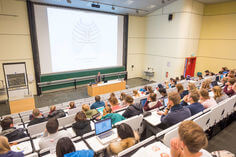Funktionelle Neuroanatomie - AG-Körber
Research summary
Mechanisms of high frequency neurotransmission
Signal processing in the auditory system, particular the auditory brainstem, relies on high fidelity, high frequency neurotransmission. Individual signal cues need to be reliably transferred between individual nuclei of the auditory brainstem at high frequency in order to ensure proper extraction and interpretation of auditory information. We are trying to understand the molecular mechanisms that enable these neurons to faithfully transmit high frequency information and that are disrupted in various forms of hearing loss. We are especially interested in specializations of the presynaptic compartments of these neurons that allow them to release neurotransmitter at high frequencies over a long period of time. As a model system, we use the calyx of Held synapse, a giant presynaptic terminal in the auditory brainstem that contains several hundred sites for neurotransmitter release, so called active zones. Due to its size, the calyx of Held is amenable to presynaptic patchclamp recordings, allowing us to perform detailed studies on presynaptic mechanisms of high frequency neurotransmission. In our lab we apply various experimental approaches including molecular biology, viral gene transfer, fluorescence microscopy, state-of-the-art electrophysiology, super resolution microscopy, electronmicroscopy and single cell gene expression profiling.
Curriculum vitae
2004 B.Sc. in Biochemistry Ruhr-University Bochum, Germany
2006 M.Sc. in Biochemistry Ruhr-University Bochum, Germany
2011 PhD in Neurobiology Heidelberg University, Germany
2011-2015 Postdoc Dept. of Functional Neuroanatomy, Heidelberg University, Germany
since 2015 Junior Group Leader Dept. of Functional Neuroanatomy, Heidelberg University, Germany
Publications
Körber, C. & Kuner, T. (2016) Molecular machines regulating the release probability of synaptic vesicles at the active zone. Front. Synaptic Neurosci. 8:5.
Körber, C., Horstmann, H., Venkataramani, V., Herrmannsdörfer, F., Kremer, T., Kaiser, M., Schwenger, D.B., Ahmed, S., Dean, C., Dresbach, T. & Kuner, T. (2015) Modulation of presynaptic release probability by the vertebrate-specific protein Mover. Neuron 87:521-33.
Kiesgen, S., Arndt, M.A.E., Körber, C., Arnold, U., Weber, T., Halama, N., Keller, A., Bötticher, B., Schlegelmilch, A., Liebers, N., Cremer, M., Herold-Mende, C., Dyckhoff, G., Federspil, P.A., Jensen, A.D., Jäger, D., Kontermann, R.E., Mier, W. & Krauss, J. (2015) An EGF receptor targeting Ranpirnase-diabody fusion protein mediates potent antitumour activity in vitro and in vivo. Cancer Lett. 357:364-373.
Körber, C., Dondzillo, A., Eisenhardt, G., Herrmannsdörfer, F., Wafzig, O. & Kuner, T. (2014) Gene expression profile during functional maturation of a central mammalian synapse. Eur. J. Neurosci. 40:2867-2877.
Pachernegg, S., Joshi, I., Muth-Köhne, E., Pahl, S., Münster, Y., Terhag, J., Karus, M., Werner, M., Ma-Högemeier, Z.-L., Körber, C., Grunwald, T., Faissner, A., Wiese, S. & Hollmann, M. (2013) Undifferentiated embryonic stem cells express ionotropic glutamate receptor mRNAs. Front. Cell. Neurosci. 7:241.
Körber, C., Horstmann, H., Sätzler, K. & Kuner, T. (2012) Endocytic structures and synaptic vesicle recycling at a central synapse in awake rats. Traffic 13:1601-1611.
Körber, C., Richter, A., Kaiser, M., Schlicksupp, A., Mükusch, S., Kuner, T., Kirsch, J. & Kuhse, J. (2012) Effects of distinct collybistin isoforms on the formation of GABAergic synapses in hippocampal neurons. Mol. Cell. Neurosci. 50:250-259.
Horstmann, H., Körber, C., Sätzler, K., Aydin, D. & Kuner, T. (2012) Serial section scanning electron microscopy (S3EM) on silicon wafers for ultra-structural volume imaging of cells and tissues. PLoS One 7:e35172.
Denker, A., Bethani, I., Kröhnert, K., Körber, C., Horstmann, H., Wilhelm, B.G., Barysch, S.V., Kuner, T., Neher, E. & Rizzoli, S.O. (2011) A small pool of vesicles maintains synaptic activity in vivo. Proc. Natl. Acad. Sci. USA 108:17177-17182.
Ma-Högemeier, Z.-L., Körber, C., Werner, M., Racine, D., Muth-Köhne, E., Tapken, D. & Hollmann, M. (2010) Oligomerization in the endoplasmic reticulum and intracellular trafficking of kainate receptors are subunit-dependent but not editing-dependent. J. Neurochem. 113:1403-1415.
Wittenmayer, N., Körber, C., Liu, H., Kremer, T., Varoqueaux, F., Chapman, E.R., Brose, N., Kuner, T. & Dresbach, T. (2009) Postsynaptic Neuroligin1 regulates presynaptic maturation. Proc. Natl. Acad. Sci. USA 106:13564-13569.
Schmid, S.M., Körber, C., Herrmann, S., Werner, M. & Hollmann, M. (2007) A domain linking the AMPA receptor agonist binding site to the ion pore controls gating and causes lurcher properties when mutated. J. Neurosci. 27:12230-12241.
Körber, C., Werner, M., Kott, S., Ma, Z.-L. & Hollmann, M. (2007) The AMPA receptor-regularoty protein g4 is a more effective modulator of AMPA receptor function than stargazin (g2). J. Neurosci. 27:8442-8447.
Körber, C., Werner, M., Hoffmann, J., Sager, C., Tietze, M., Schmid, S.M., Kott, S. & Hollmann, M. (2007) Stargazin interaction with ?-Amino-3-hydroxy-5-methyl-4-isoxazole propionate (AMPA) receptors is critically dependent on the amino acid at the narrow constriction of the ion channel. J. Biol. Chem. 282:18758-66.
Kott, S., Werner, M., Körber, C. & Hollmann, M. (2007) Electrophysiological properties of AMPA receptors are differentially modulated depending on the associated member of the TARP family. J. Neurosci. 27:3780-3789.
Ma, Z.-L., Werner, M., Körber, C., Joshi, I., Hamad, M., Wahle, P. & Hollmann, M. (2007) Quantitative analysis of co-transfection efficiencies in studies of ionotropic glutamate receptors. J. Neurosci. Res. 85:99-115.




